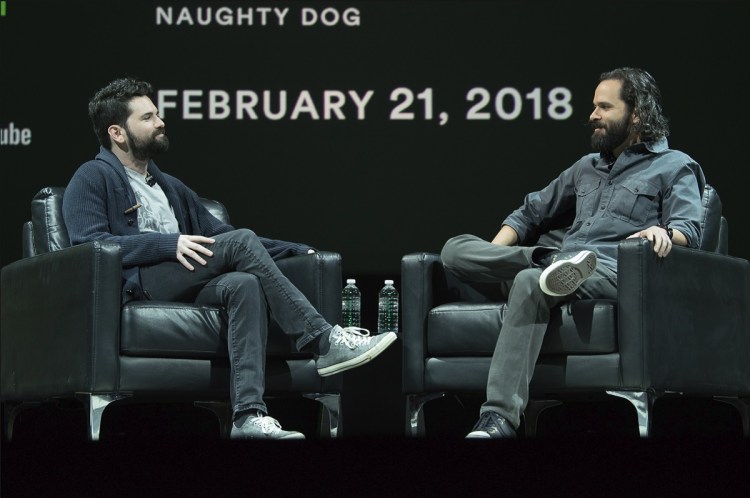Neil Druckmann of Naughty Dog is one of the creative forces behind the popular Sony PlayStation games like the Uncharted series and The Last of Us — both of which have swept some of the biggest awards in the game business.
Dan Trachtenberg, director of 10 Cloverfield Lane and the Playtest episode of Black Mirror, interviewed Druckmann onstage last week during the DICE Summit, the elite game conference in Las Vegas. It was fascinating for me to watch as Druckmann talked about the inspirations behind his games (which are among my favorites), which have gotten more gritty and elevated over time. Somewhere along the line, Druckmann and his colleagues at Naughty Dog graduated to the next level of storytelling, just as director Steven Spielberg did.
Trachtenberg said that the Uncharted series was akin to a game version of Spielberg’s Raiders of the Lost Ark.
But Trachtenberg said Naughty Dog’s The Last of Us “really takes that to the next level in pairing incredibly grounded, gritty, emotional storytelling with big thrills,” much like in later Steven Spielberg story-based movies such as E.T. or Close Encounters of the Third Kind.
“You’re still delivering a commercial experience, but with indie sensibilities and a real mind for storytelling in a way we don’t get in games,” Trachtenberg said.

Above: Dan Trachtenberg interviews Neil Druckmann (right) about the inspirations behind The Last of Us and Uncharted 4: A Thief’s End.
Humble beginnings
Druckmann said he didn’t really think of games as a profession when he was growing up in Israel (he moved to the U.S. in 1989 at the age of 10). He played narrative-based games such as King’s Quest, Space Quest, and The Secret of Monkey Island. He was also a fan of action games like Double Dragon, Streets of Rage, Outrun, and Mario. He started to see how you could combine action and character-driven stories in games.
“When I was thinking about getting into games, it was very much with the mindset of how we tell better stories,” Druckmann said.
He played Half-Life in high school and was blown away by the story in that first-person shooter title from Valve.
“You could tell a cinematic story with no cut scenes,” he said.
He saw Children of Men, and he walked out of the theater wondering why games didn’t tell intimate stories like this one.
“You could tell we drew a lot of inspiration for The Last of Us from Children of Men,” Druckmann said.
He studied computer science at Carnegie Mellon University, and he landed a gig as an intern at Naughty Dog, the maker of the Crash Bandicoot series, in Los Angeles. In 2004, he became a programming intern on Jak 3 and Jak X: Combat Racing. Then he moved on to become a game designer for Uncharted: Drake’s Fortune with Amy Hennig.
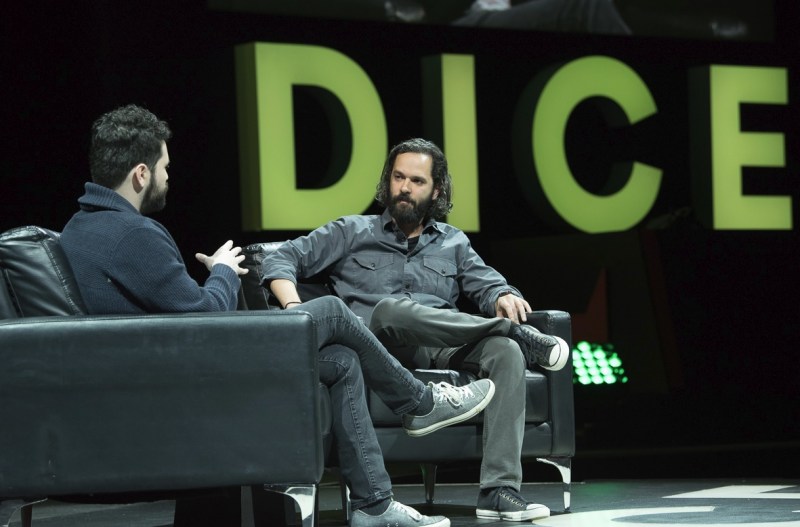
Above: Neil Druckmann (right) of Naughty Dog says The Last of Us started out as a pitch for a zombie film.
Naughty Dog’s evolution
“I was at this studio, which was making these cartoony action mascots, and now we’re doing this grounded title with a character who doesn’t have these crazy outfits,” Druckmann said. “It was telling this grounded, personal story. I was so stoked for this hero. To get on it and help, I felt I was the luckiest person.”
He added, “It wasn’t like games hadn’t told great stories before. At Naughty Dog, we were trying to come at things less from a set-piece design approach, which we did with Jak & Daxter. Daxter is going to ride a missile. Cool, we’ll figure out later how that fits into a story. [With Uncharted], we had to think about the character’s motivation and ultimately what this thing was about.”
Those characters in the story-based came could still be used in epic action scenes (set pieces), but these had to make sense in the context of the narrative.
The Last of Us
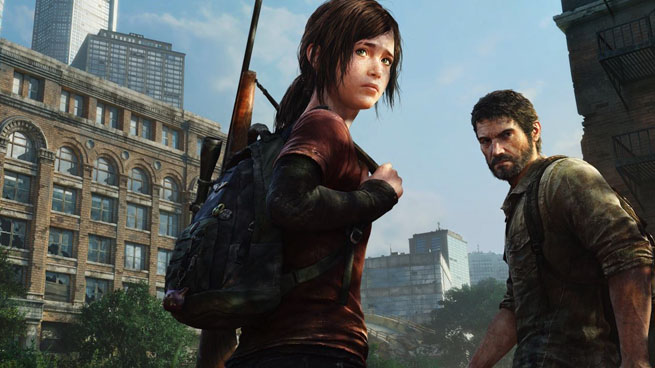
Above: The Last of Us featured a deep, evolving relationship between Ellie and Joel.
“For me, my journey with The Last of Us started with a failed student project,” Druckmann said.
At Carnegie Mellon, Druckmann pitched a zombie game to filmmaker George Romero based on Night of the Living Dead. The idea was to combine Ico (where a warrior escorts a princess through many dangers) with characters from Sin City, where a guy has to protect a girl and you have a hand-holding mechanic like in Ico. At some point, the guy had a heart condition and you had to take control of the girl and protect the guy.
“George Romero picked a totally different pitch from that one,” Druckmann said. “I liked that idea so much that I kept toiling away at it. I thought, maybe it could be a comic book. I pitched it to Image Comics. They told me they liked it but didn’t love it. We’re going to pass. That projected failed again, so I shelved it.”
Years later, at Naughty Dog, the studio heads decided to split into two teams, one doing Uncharted 3 and another doing a Jak & Daxter game. But the latter team’s advocates had left, and it didn’t really come together. So then Druckmann and Bruce Straley revived Druckmann’s zombie game pitch and worked on character designs.
“This thing grew and evolved and became The Last of Us,” Druckmann said.
“That is crazy,” Trachtenberg said. “It’s crazy that the initial idea about switching and the girl is helping the guy manifests itself in a stunning moment in The Last of Us that games rarely do.”
Trachtenberg said that when he writes scripts for movies, he doesn’t have to be a slave to game mechanics. Druckmann said, “I envy you.”
But Trachtenberg said movies are slaves to genres, conventions for suspense, and other expectations.
With games, Druckmann said that the game mechanics have to be prototyped and tested to see if they are fun. If they aren’t fun, then whole chunks of the story may have to change or disappear. The Last of Us is an action survival shooter game, a familiar gameplay genre. It has a different narrative genre, with some story similarities to films like Road to Perdition or Aliens or the zombie genre.
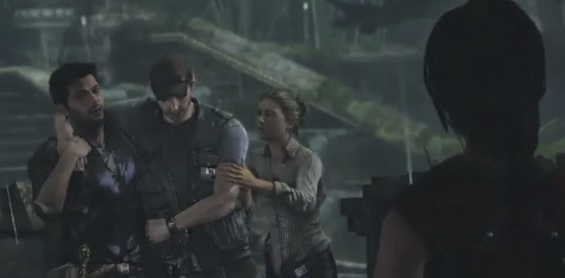
Above: A scene from Uncharted 2: Among Thieves.
“What expectations do players have for gameplay, and how do we subvert it sometimes?” Druckmann said. “In Uncharted 2, we leveraged Jeff the cameraman elegantly.”
In that part of the game, the hero Nate had to decide whether to side with Chloe and leave the injured man behind, or to help him at great risk and save him. All of a sudden, Nate can’t do all the moves he was doing before. Now he is handicapped while helping Jeff.
“You feel out the narrative element through gameplay,” Druckmann said. “It took a lot of convincing to say it is OK to make something frustrating when it’s helping the overall experience. It helps what you are trying to do with the characters. It helps with the arc of the characters.”
At some point in The Last of Us, the hero, Joel, gets injured and the sidekick, Ellie, comes to the fore. That required the creation of a new set of gameplay technology and animations, but they were necessary to serve the story.
“The whole concept of The Last of Us is trying to build a bond, and trying to replicate the mechanics and storytelling of a bond of father and a daughter,” Druckmann said. “It felt that was so important to pull off, to feel Ellie’s panic, and to feel her starting to take charge. That’s the hand-off of a baton, because in the next sequence, you are playing as Ellie. I felt if we dropped the ball in that sequence, when you are playing as Ellie, it wouldn’t have turned out as magical as it was for a lot of players.”
Beginnings and endings
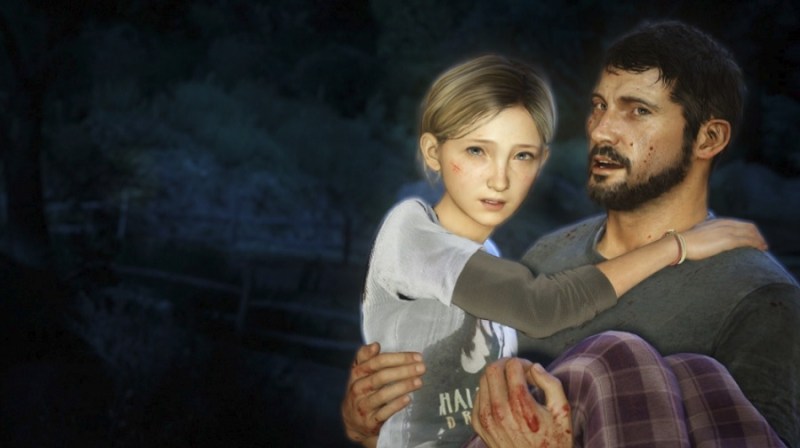
Above: The beginning of The Last of Us.
Sometimes, the narrative didn’t win out due to scheduling challenges. In Uncharted 4: A Thief’s End, Druckmann said there was a flashback sequence with two kids, two brothers. There was a moment where you could find two swords, and there was a whole sword fighting mechanic. You could practice fighting, and then, at the end of the game, you would fight the villain with a sword, using the sword fighting skills that you had learned in that earlier scene. Sadly, that flashback had to be cut.
“Beautiful,” Trachtenberg said. “It was a tutorial, and it would also have pulled at the nostalgia strings.”
As for game openings, Trachtenberg said that The Last of Us had one of the best openings of all time. I agree. But Trachtenberg asked Druckmann how it’s possible to immerse the player in the story of the game at the outset, but also teach the player how to play the game at the same time in a tutorial.
“As a team, we hold off starting production on the introduction as much as possible,” Druckmann said. “For new intellectual property, we don’t know what the game is. Until you get on the stick, you don’t know what works.”
That is because the developers don’t know which game mechanics are going to work and become prototypes and then become full systems, accompanied by animations. Once you find out what’s fun, then you can return to the beginning and craft it.
“This goes the other way as well, as we can’t work on the ending until we know what our core systems are,” Druckmann.

Above: Joel with Ellie toward the end of The Last of Us.
It’s so striking that the beginning of The Last of Us and the end of the game are so similar, like bookends.
With the beginning of The Last of Us, Naughty Dog delayed the training part where you learn how to shoot until later, when you are in a tunnel and you come upon a guy wearing a gas mask. You are asked whether you want to perform a mercy killing, to save the man from becoming a zombie-like creature, and that’s where you learn how to shoot the gun.
It sounds like these are hassles for game developers, in comparison to movies. But Druckmann said he has changed his mind about whether Uncharted would make a good movie. Instead of remaking the game, Druckmann wants an Uncharted movie to be set in the universe, possibly with different characters.
“We have evolved our feelings toward this kinds of adaptations over the years. As time goes on, we are not excited by a direct adaptation of a story for a game into a movie,” Druckmann said. “We have told that story well, cinematically. The idea for The Last of Us film was to be a direct adaptation. I don’t want that movie to be made. Maybe something could be done in the world. For me, I know and for our fans, Nolan North is Nathan Drake. Troy Baker is Joel. It’s very disorienting to see someone else in that role.”
I caught up with Druckmann afterward briefly and noted how The Last of Us had humble beginnings with that George Romero pitch. He said that he looked forward to seeing my reaction to The Last of Us Part II, which he is working on now.
